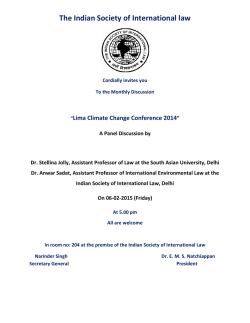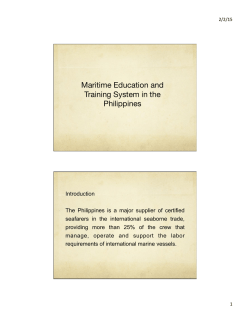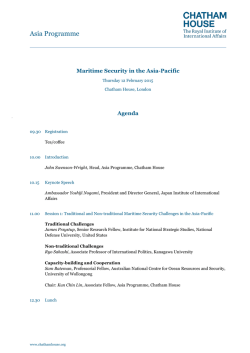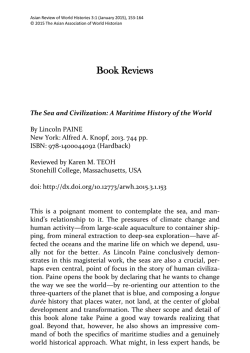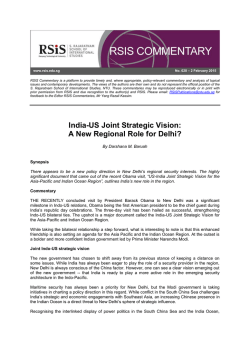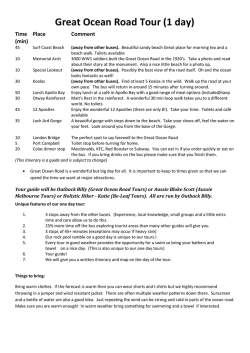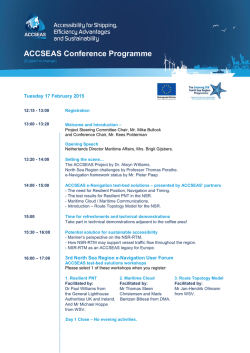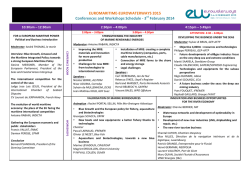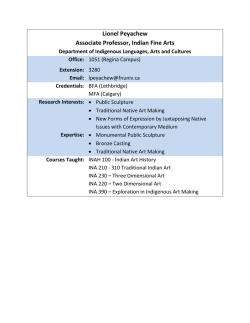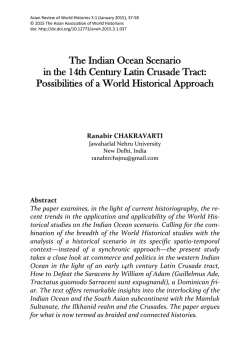
View PDF - Asian Review of World Histories
Asian Review of World Histories 3:1 (January 2015), 137-151 © 2015 The Asian Association of World Historians doi: http://dx.doi.org/10.12773/arwh.2015.3.1.137 Review Article Notes on World History and Maritime History Michael N. PEARSON Emeritus Professor, University of New South Wales Sydney, Australia [email protected] WORLD HISTORY The modern notion of “world history” is a relatively new, and still largely misunderstood, concept. Yet it is very much on the scholarly agenda today. Perhaps confusingly, world history does not aim to deal with everywhere on our globe. Nor is it all the history of all of the world, just as world music is not the music of the whole world. Political economists, especially those associated with Immanuel Wallerstein’s concept of world-systems, have for long been explicitly writing “world history.” Over forty years ago Wallerstein introduced the notion of the Modern World-System, which did not incorporate the whole globe until late in the nineteenth century. 138 | ASIAN REVIEW OF WORLD HISTORIES 3:1 (JANUARY 2015) Before this, he uses the terminology of “a ‘world’ system, not because it encompasses the whole world, but because it is larger than 1 any juridically-defined political unit.” So also with the less explicitly economist “world historians” and their mouthpieces, notably the Journal of World History and the Journal of Global History. The man who arguably was the crucial entrepreneur, the late Jerry H. Bentley, was clear that world history does not have to include the whole world. Rather it is “a historical perspective that transcends national frontiers.” Scholars need “a regional, continental, or global scale” to look at many important forces in history. The key is to get 2 away from national, state-based histories. World history investigates themes, trends, relationships which extend beyond the bounds of any particular “state.” So also with a new venture by Oxford University Press called the New Oxford World History. The preface by the editors of the whole series, Bonnie G. Smith and Anand Yang, claim that this “new” world history aims to consider “both the separate and interrelated stories of different societies and cultures . . . it emphasizes connectedness and interactions of all 3 kinds.” We must distinguish between “world history” and “global history,” as elucidated by Bruce Mazlish. He critiques various attempts to define “global,” and “world,” and concludes that the “heart and novelty of global history” is to consider “the history of globalization.” When we do this we then need to consider two questions: “What is involved in globalization? And what are the 4 factors at work in our contemporary world?” Maria Fusaro’s chapter in Maritime History as Global History contains a very useful overview of recent work on world and global history, with extensive bibliography. More recently Michael Lang has provided an ex1 Immanuel Wallerstein, The Modern World-System, 4 vols. (New York: Academic Press, 1974-2011), 1:15. 2 Jerry Bentley, introduction to Journal of World History 1, no 1 (Spring 1990): iii-v. 3 Edward A. Alpers, introduction to The Indian Ocean in World History (New York: Oxford University Press, 2014), ix-x. 4 Bruce Mazlish, “Comparing Global History to World History,” Journal of Interdisciplinary History 28, no. 3 (1998): 385–95. REVIEW ARTICLE | 139 cellent overview and critique of the way historians have written 5 about global matters. Leaving global and world aside for now, clearly there is a difference between “world history” and “world-system” history. The latter, as promoted by Immanuel Wallerstein, is both more rigorous and more restrictive than the former. World history is rather diffuse and even unfocused. This has both positive and negative results. On the one hand it means that world history is not shackled by a particular strait jacket of neo-Marxist theory, but on the other hand it does lack the attractive totalizing ambitions of worldsystem theory. Whether successfully or not, Wallerstein and his followers do aim to explain how we got to where we are, and even where we are going. The grandeur of this enterprise and vision are obviously not to everyone’s taste. World-system notions have of course also been attacked from various directions. An important critique of Wallerstein is that he found Europe to be the driving force, a notion trenchantly, and successfully, challenged by Andre Gunder Frank. More recently several scholars have extended this sort of neo-Marxist analysis back in time. The following comments from an archaeological stance are relevant here: Many archaeologists have used world-systems analysis in precapitalist settings. Some have criticized it; others have dismissed it out of hand. Critiques include that it was developed for the ‘modern’ world, that it is overly economistic, that it neglects individual actors, and that it inappropriately uses modern analyses in ancient settings. Although there is some validity to these charges when applied to Wallerstein’s original formulation, most are misdirected. The critiques are rooted in inattention to the last three decades of work on world-systems, especially modifications made with the explicit intention to make world-systems analysis useful in precapitalist settings. Newer comparative versions of world-systems analysis were initially developed to better understand the evolution of world-systems that gave rise to the modern world5 Michael Lang, “Histories of Globalization(s),” in A Companion to Global Historical Thought, ed. Prasenjit Duara, Viren Murthy, and Andrew Sartori (Maiden, MA: Wiley/Blackwell, 2014), 399-411. 140 | ASIAN REVIEW OF WORLD HISTORIES 3:1 (JANUARY 2015) system. These new advances are useful for the study of interregional 6 interactions and long-term development. A very recent overview by a follower of Wallerstein, a skeptical one to be sure, brings the debate up to the present and provides a use7 ful overview of dependency and world-systems analyses. MARITIME HISTORY More to the point, there have been attempts to write world-system history from an oceanic perspective. Immanuel Wallerstein many years ago tried this, or at least his chapter was in a book on the In8 dian Ocean. A much better example is Philippe Beaujard’s vast two volumes, a stunning work, beautifully presented, challengingly 9 erudite, and ambitious in its claims. Proponents of a world historical approach have long seen oceans as obvious places appropriate for this sort of study, while a focus on states, or continents, is increasingly seen as unsatisfactory. Jerry Bentley set out the crucial question: “Granting that received constructs such as continents, civilizations, areas (as in ‘area studies’), and even nations are exceedingly problematic, can alternative constructs organized around sea or ocean basins serve as more useful categories for purposes of conceptualizing the world and understanding its historical dynamics?” World, or global, history is a comparatively new field, and within this oceans are a prime example of a relevant and important arena. An oceanic study seems to fulfill rather precisely what Bentley defined as world his6 Thomas D. Hall, P. Nick Kardulias, and Christopher Chase-Dunn, “World-Systems Analysis and Archaeology: Continuing the Dialogue,” Journal of Archaeological Research 19, no. 3 (2011): 233–79. 7 Ravi Arvind Palat, “Dependency Theory and World-Systems Analysis,” in A Companion to Global Historical Thought, 369-83. 8 Immanuel Wallerstein, “The Incorporation of the Indian Subcontinent in the Capitalist World-Economy,” in The Indian Ocean: Explorations in History, Commerce and Politics, ed. Satish Chandra (New Delhi: Sage, 1987), 222-52. 9 Philippe Beaujard, Les Mondes de l’Océan Indien (Paris: Armand Colin, 2012). REVIEW ARTICLE | 141 tory: treating as its key themes large scale population movements and economic fluctuations, cross cultural transfer of technologies, the spread of infectious diseases, long distance trade and the 10 spread of religious faiths, ideas and ideals. Several recent books, while not specifically claiming to be world history, show how a maritime focus can produce wide ranging analyses which get away from the strait jackets of state or continent based histories. I am thinking of Sherrif on the dhow trade, Mack on the sea tout court, and Gillis’s stunning work on the sea11 shore. Environmental history presumably is also a type of world history. The interesting point is that there has recently been a move to fill the “blue hole” in this subfield by turning attention to the sea, thus rectifying what used to be the terracentrism of the field. Maritime environmental history then can be seen as merging nicely world themes with maritime ones. John McNeill wrote an important early contribution, and among more recent work that by Jeffrey Bolster should be noted, if only because his credibility is enhanced by the fact that he is a licensed master mariner who spent ten years as a ship’s captain. In 2006 he published a short statement promoting maritime environmental history, and more recently he wrote a prize-winning book on the North Atlantic. Bolster, along with the organizers Franziska Torma and John Gillis, was also prominent at an important conference at the Island Institute in Rockland, Maine in 2011 called “Final Frontiers: maritime environmental history.” Some of the proceedings will appear in a 12 publication from White Horse Press. 10 Jerry H. Bentley, “Sea and Ocean Basins As Frameworks of Historical Analysis,” Geographical Review 89, no. 2 (April 1999): 215-24. 11 Abdul Sherrif, Dhow Cultures of the Indian Ocean: Cosmopolitanism, Commerce, and Islam (New York: Columbia University Press, 2010); John Mack, The Sea: A Cultural History (London: Reaktion Books, 2011); John Gillis, The Human Shore: Seacoasts in History (Chicago: University of Chicago Press, 2012). 12 J. R. McNeill, “Of Rats and Men: A Synoptic Environmental History of the Island Pacific,” Journal of World History 5, no. 2 (Fall 1994): 299-349; W. Jeffrey Bolster, “Opportunities in Marine Environmental History,” Environmental History 11, no. 3 (July 2006): 567-97; W. Jeffrey Bolster, The Mortal Sea: Fishing the Atlantic in the Age of Sail (Cambridge, Mass.: Harvard University Press, 2012). 142 | ASIAN REVIEW OF WORLD HISTORIES 3:1 (JANUARY 2015) There have been several overviews of the state of maritime history. Indeed a recent overview by Lincoln Paine makes a very bold claim about the potential for maritime history. “I want to change the way you see the world. Specifically, I want to change the way you see the world map by focusing your attention on the blues that shade 70 percent of the image before you, and letting the earth tones fade. This shift in emphasis from land to water makes many trends and patterns of world history stand out in ways 13 they simply cannot otherwise.” All well and good, though it is debatable whether he has succeeded in writing a maritime history which is centrally aquatically focused: the land still intrudes, as perhaps is inevitable. Leaving this aside, maritime history has recently been subjected to a host of compelling analyses and overviews, though the ones I will mention here do not engage specifically with my main concern, that is world history and maritime history. Karen Wigen has been prominent here, both in her introduction to an important collection, and as editor of a major overview in the American Historical Review which contained major articles 14 on the historiography of the Atlantic, Pacific and Mediterranean. The gap in the AHR symposium, the Indian Ocean, was filled by 15 Markus Vink. My own bibliographic survey of the state of Indian Ocean studies is already out of date, but I have now published a more general survey of the state of oceanic history generally, from 16 which I will draw from time to time in what follows. Several of Rila Mukerjee’s contributions survey Indian Ocean historiography, most successfully perhaps in her article “The Indian Ocean: Histo13 Lincoln Paine, The Sea and Civilization: A Maritime History of the World (New York: Knopf, 2013), 3. 14 Karen Wigen, ed., “Oceans of History,” American Historical Review 111, no. 3 (June 2006): 717-80; K. Wigen, introduction to Seascapes: Maritime History, Littoral Cultures and Transoceanic Exchanges, ed. Jerry H. Bentley, Renate Bridenthal, and Karen Wigen (Honolulu: University of Hawai’i Press, 2007). 15 Markus Vink, “Indian Ocean Studies and the ‘New Thalassology’,” Journal of Global History 2, no. 1 (2007): 41-62. 16 Michael N. Pearson, “History of the Indian Ocean: A Review Essay,” Wasafiri 26 (2011): 78-85; Pearson, “Oceanic History,” in A Companion to Global Historical Thought, 33750. REVIEW ARTICLE | 143 rians Writing History,” of which more later. The venerable journal Mariner’s Mirror included several important overviews and critiques in a recent issue, especially articles by Richard Harding and 17 Lewis R. Fischer. Nor is it only historians. Kimberley Peters, a geographer, recently wrote a very useful survey of the “field,” if this inappropriate word be allowed when writing about oceans. She laments the way in which geographers writing on contemporary themes continue to belittle or ignore the sea. She also berates her disciplinary fellows for leaving the action to historians. It is interesting that she quotes extensively Philip Steinberg’s seminal work, he of course also being a geographer. Peters later wrote an article with William Hasty which picks up many of the same themes, but with specific reference to the ship as a potentially fruitful object of study for geogra18 phers. This reminds us of Marcus Rediker’s many (sometimes inflammatory) analyses of ships in the Atlantic, to which could be added several innovative works by Clare Anderson on the Indian 19 Ocean, and my own preliminary study for an earlier period. WORLD HISTORY AND MARITIME HISTORY There have recently been several conscious attempts to write about world history and the role that maritime history can play. It is very appropriate that the examples I have found most useful are often 17 Richard Harding, “The Society for Nautical Research: Where are we now and where are we going?” The Mariner’s Mirror 97, no. 1 (February 2011): 10-21; Lewis R. Fischer, “Are We in Danger of Being Left with Our Journals and Not Much Else: The Future of Maritime History,” in Ibid., 366-68. 18 Kimberley Peters, “Future Promises for Contemporary Social and Cultural Geographies of the Sea,” Geography Compass 4, no. 9 (September 2010): 1260-72; William Hasty and Kimberley Peters, “The Ship in Geography and the Geographies of Ships,” Geography Compass 6, no. 11 (November 2012): 660-76. 19 For example, Clare Anderson, “‘The Ferringees are Flying–the Ships is Ours!’: The Convict Middle Passage in Colonial South and Southeast Asia, 1790-1860,” Indian Economic and Social History Review 42, no. 2 (2005): 143-86; Pearson, “Class, Authority and Gender on Early Modern Indian Ocean Ships: European and Asian Comparisons,” South African Historical Journal 61, no. 4 (2009): 680-701. 144 | ASIAN REVIEW OF WORLD HISTORIES 3:1 (JANUARY 2015) by scholars whose work is included in this collection. The already cited article by Rila Mukherjee ends with a brief discussion of world history and the Indian Ocean. She is content to problematize the matter rather than issue firm directives. “Is the ocean a theater 20 for world history, or merely a stage for a regional history?” Directly relevant to my concerns is the important collection edited by Maria Fusaro and Amélia Polónia. Overviews by the two editors open and close the volume, with several valuable case studies making up the middle. The chapters by the two editors in Maritime History as Global History contain copious bibliography relating to all the oceans, and also an interesting analysis of the areas on which maritime historians have recently been working. The editors are commendably modest and problematizing in their comments, yet the over arching theme seems clearly to be, as Polónia puts it, that “we believe that maritime history in its broadest sense is global in the sense of a ‘total history.’” Several other themes stand out, including the important point that maritime history must stray beyond disciplinary boundaries to include, for example, climate change, oceanography, meteorology, and archaeology. Perhaps most importantly, Fusaro sees as absolutely fundamental “the issue of how to work towards the creation of truly maritime global histo21 ries.” This is the quest, to be sure a complex and hazardous one, on which we have embarked. Finally, I would like to recommend Edward E. Alpers recent text, specifically an oceanic history in a world history framework. He does extremely well is writing about the Indian Ocean as both an enclosed system or network or “world,” and at the same time part of a wider, global, history. 20 Rila Mukherjee, “The Indian Ocean: Historians Writing History,” Asian Review of World Histories 1, no. 2 (July 2013): 295-307. 21 Maria Fusaro and Amélia Polónia eds., Maritime History as Global History (St. John's, Nfld.: International Maritime Economic History Association, 2010), 279. REVIEW ARTICLE | 145 PROBLEMS AND OPPORTUNITIES In a modest way I hope I can advance the discussion by suggesting some hazards to be avoided as we try to connect world and maritime history. My intention in this short piece is to say a little about the historiography of several different oceans, my aim being to show that some oceans are much more susceptible to a world history approach than are others. I will make a series of observations, most of them obvious enough. If we look at the three greatest oceans, we must at once admit that they are by no means homogeneous bodies of water. For example, the Pacific includes the tropical waters with which we are most familiar, but also Arctic and Antarctic waters seasonally covered in ice or icebergs. The general term Indian Ocean ignores the fact that there is a monsoon Indian Ocean, down to about 10 degrees S, and a very different one below this, where cold fronts rather than predictable monsoons prevail. Below this are the roaring 40s and perilous 50s, where westerly winds circle the southern globe. Historians have often written about only part of an ocean while claiming to cover it all. The most obvious example is Atlantic studies, which all too often are really about only the north Atlantic, especially connections between the USA and Western Europe. The African and south American parts of the Atlantic have received must less attention. Another problem is that oceans are not discrete and enclosed. They obviously flow into each other, and should not be studied as unconnected entities. In the early modern period bullion from South America flowed seamlessly over three oceans: the Atlantic, the Pacific and the Indian. Oil today spans the globe, not just one ocean. Tuna and sharks travel vast differences regardless of our separations. Then we need to consider different sorts of histories of oceans, and different ways of approaching parts of all of various oceans. David Armitage’s work on the Atlantic may have general applicability. He finds three categories. First is circum-Atlantic history, which emphasizes circulation and exchange across an ocean considered to have geographical and historical unity. Second is 146 | ASIAN REVIEW OF WORLD HISTORIES 3:1 (JANUARY 2015) trans-Atlantic history, which involves comparative studies. Finally, cis-Atlantic history looks at the history of a landed area, maybe a port or a state, within an Atlantic context. Thus maybe Ireland, or Scotland, could be better understood if they were more firmly integrated into the Atlantic, rather than Britain. More recently conjuncto-Atlantic history has been added by Peter Coclanis, this being the way the Atlantic connected with other parts of the globe 22 and other oceans. This is of course a reminder that oceans are not discrete entities. None can be studied in isolation from other bodies of water, or indeed from the lands which surround them. Earlier maritime histories were often bedeviled by traces of Eurocentrism, precisely the sort of thing world history tries to avoid. They were often really the story of the triumph of the west, such as Ballard’s Rulers of the Indian Ocean, or Hall’s Empires of the 23 Monsoon, which has a bit too much on Europeans. So also, in much more modulated form, Oskar Spate’s history of the Pacific. He wrote that “This is a history of the Pacific, not of the Pacific peoples. But then there was not, and could not be, any concept ‘Pacific’ until the limits and lineaments of the Ocean were set: and this was undeniably the work of Europeans . . . The fact remains that until our own day the Pacific was basically a Euro-American 24 creation, though built on an indigenous substructure.” Earlier Atlantic books tended to provide justifications for imperialism and support for notions of racial or ethnic superiority. Paul Butel wrote, inexcusably, of Africa as the “dark continent”—and this was as re25 cently as 1999. Indeed, one could argue that giving the Mediterranean, which after all is only a sea, equal status with the three 22 David Armitage, “Three Concepts of Atlantic History,” in The British Atlantic World, 1500–1800, ed. David Armitage and Michael J. Braddick (New York: Palgrave Macmillan, 2002), 11–27; Peter A. Coclanis, “Beyond Atlantic History,” in Atlantic History: A Critical Appraisal, ed. Jack P. Greene and Philip D. Morgan (New York: Oxford University Press, 2009), 337-56. 23 G. A. Ballard, Rulers of the Indian Ocean (London: Duckworth, 1927); Richard Hall, Empires of the Monsoon (London: HarperCollins, 1998). 24 O. H. K. Spate, The Pacific Since Magellan, 3 vols. (Canberra: Australian National University Press, 1979-1988), 1:ix. 25 Paul Butel, The Atlantic (New York: Routledge, 1999), 185. REVIEW ARTICLE | 147 great oceans is a surviving vestige of orientalism. Just because it was the cradle of western civilization does not have to mean that it receives as much attention as say the much bigger and older Indian Ocean. Our ur-text, Braudel’s Mediterranean, opens up several controversial areas which are of general applicability for maritime history. A central flaw in his great book, one generally recognized for some time, is his lack of familiarity with, even antipathy towards, the southern, Muslim shore of his sea. Others have complained that he pessimistically downplays human agency in favor of broad historical processes which have a certain inevitability, though I imagine this would be of slight concern to most world historians. The more recent criticism has to do with his fundamental concept of maritime history, one which goes far inland. For Braudel the Mediterranean is a very wide zone: “We might compare it to an electric or magnetic field, or more simply to a radiant centre whose light grows less as one moves away from it, without one’s being able to 26 define the exact boundary between light and shade.” Mack claims that “the sea (or seas) is less his [Braudel’s] focus than the wider region which includes an extensive hinterland” and indeed the word Mediterranean is revealing, for it means the space inbetween lands. More generally “the seas are portrayed either as the backdrop to the stage on which the real action is seen to take place— that is, the land—or they are portrayed simply as the means of connection between activities taking place at coasts and in their interiors. The characteristics of the sea itself, the nature of man’s interactions with it, the alliances and liaisons which take place on it and because of it, the contracts effected, cemented or cast asunder, 27 are all largely absent from this historiography.” Related to this is a central governing factor, one raised most directly by Horden and Purcell for the Mediterranean. They found “a distinction between history in the Mediterranean—contingently 26 Fernand Braudel, The Mediterranean and the Mediterranean World in the Age of Philip II, 2 vols. (London: Collins, 1972), 1:168. 27 Mack, The Sea, 19-20. 148 | ASIAN REVIEW OF WORLD HISTORIES 3:1 (JANUARY 2015) so, not Mediterranean-wide, perhaps better seen as part of the larger history of either Christendom or Islam—and history of the Mediterranean—for the understanding of which a firm sense of place and a search for Mediterranean-wide comparisons are both 28 vital.” Edward Alpers’ recent excellent text follows much the same lines, for he notes that the Indian Ocean world was “both an internally connected world region ad one that was globally linked to the 29 rest of the world.” As world historians which one are we doing, and at what time? Thinking about the Mediterranean reminds us that size matters; we can’t assume that all bodies of water with familiar names can be analyzed in the same way. Obviously more confined maritime spaces had more of their area nearer the coast and thus subject to having landed norms about control and taxation applied to them. The Mediterranean is a sea, tiny as compared with the great oceans, so that one could expect much more imbrication with the land as compared with the global reach of the Atlantic and Pacific. Horden and Purcell note that in the Mediterranean “There are only relatively restricted zones where, in the clearest weather, sailors will find themselves out of sight of land.” Their map showing which areas are out of sight of land shows very clearly that large parts of 30 this sea were within eye sight of the coast. The comparison with the Indian Ocean is obvious—a vast body of water covering some 73 million square kms, though if we restrict ourselves to the monsoon Indian Ocean, that is down to 10 degrees S, we are looking at perhaps 30 million square kms. The Pacific covers 165 million square kms, the Atlantic 106 million. By contrast, the Mediterranean is only 2.5 million square kms. Still on the theme of different oceans, it may be that some are more homogeneous, and thus more susceptible to world history analysis, than are others. Yet really all of them are very diverse. 28 Peregrine Horden and Nicholas Purcell, The Corrupting Sea: A Study of Mediterranean History (Oxford: Blackwell, 2000), 1:43. 29 Alpers, Indian Ocean, 127. 30 Horden and Purcell, The Corrupting Sea, 126, map on 127. REVIEW ARTICLE | 149 For example, many histories of the Atlantic are in fact histories of the North, Anglophone, Atlantic. Arguably this area has enough commonalities to be fruitful as a site for a world history approach. But maybe the whole Atlantic is so diverse as to make finding meaningful common themes very elusive indeed, if not impossible. Great complexity around the littorals may indeed hinder any attempt at world history, and this may, as we noted earlier in another context, apply even to the tiny Mediterranean. And if this is the case, what of the Indian Ocean, with many languages, about 40 different political units, great variations in climate and geography. Maria Fusaro quotes Harklafris as saying that maritime history can “provide a methodology for linking the local, the regional, the na31 tional, the international, the global . . .” Fusaro is not convinced, and nor am I, for as I have just noted in most oceans there are too many locales and regions for valid overarching analysis to be possible. The historiography of the Pacific raises other problems for us. Some authors stress islands, other the more terrestrial rim countries in their perception of what the Pacific is. We have then again the contrast between aquatic histories, and histories which while purporting to be about an ocean in fact give primacy to the land, just as we noted with reference to Braudel. Over the last few decades several authors writing on the Pacific have rejected imperial strait jackets, and written about islands and way faring. This is in contrast with earlier work which focused on the Pacific rim countries, and ignored the islands. “The sea connected islands rather than separating them—a fundamental difference between European and Pacific perceptions of the maritime world.” “‘Oceania’ connotes a sea of islands with their inhabitants. The world of our ancestors was a large sea full of places to explore, to make their homes in, to breed generations of seafarers like 32 themselves. People in this environment were at home in the sea.” As Thomas writes in his study of Captain Cook, “From the perspec31 32 Fusaro, Maritime History, 268-69. Mack, The Sea, 65, 72. 150 | ASIAN REVIEW OF WORLD HISTORIES 3:1 (JANUARY 2015) tives of its Polynesian inhabitants . . . it was no fluid emptiness [as it was in the eighteenth century for Europeans], but a place of marine paths suspended beneath a stellar map. From Micronesia in the north-west to Hawaii in the east and New Zealand in the far south, Islanders knew currents, constellations, routes and the places and people at the end of them as well as any Baltic trader knew his passages.” When Captain Cook got to Rapanui, aka Easter Island, he found they spoke “variants of Tahitian, Tongan and Maori words. The staggering thing was that Rapanui lay thousands of miles from Tahiti. ‘It is extrordinary [sic],’ Cook wrote, ‘that the same Nation should have spread themselves over all the isles of this Vast Ocean from New Zealand to this Island which is almost a 33 fourth part of the circumference of the Globe’.” Yet on a skeptical note, to say that the history of the Pacific is the history of Polynesian seafaring could be far too restrictive. What of the rim countries, which are privileged by Spate and others, yet ignored by the scholars following David Lewis’s We the Navigators. Which is the right balance; and can one give adequate recognition to both in one work? It seems that the modern Pacific writers have decided on a purely aquatic history. This certainly is valid for the period before European dominance, but has become less convincing over the last two centuries. This said, a contemplation of the countries making up the rim shows a formidable and maybe insurmountable variety, going from New Zealand to Chile and (excluding island states) including around 20 modern states: can a location on the Pacific unite all these? I think not. And in contrast to the emphasis of those following in the wake of Epeli Hau’ofa and Lewis, before Europeans arrived there were settled states and kingdoms. The Tongan kingdom had a population of 30,000-40,000. There were four kingdoms in the Hawaiian Islands with populations from 30,000 up to 120,000. Kosrae was unified into one polity of 6,000 to 10,000 people. Formed in the CE 1000s-1400s, these kingdoms had centuries of 33 Nicholas Thomas, Discoveries: The Voyages of Captain Cook (London: Penguin, 2003), 225. REVIEW ARTICLE | 151 history, documented with lengthy royal and chiefly genealogies and associated oral histories. Rulers usually inherited their positions, and the high chiefs primarily had close blood ties with the rulers. These elite controlled their polities’ lands and people, commanded deference, and received vast amounts of food and valuables in tribute. They had enough wealth to support craftsmen, elite warriors, composers-choreographers-genealogists and servants, 34 who lived near their dwellings, forming courts. If we as world historians want to use the Pacific as a unit of analysis, these various problems and differences have to be taken into consideration. To conclude on a very skeptical note, it could be that the variations are so profound that we may decide the Pacific, or maybe any other ocean, is simply not a category or template which we can use to write world history. 34 Ross Cordy, “The Built Environment of Polynesian and Micronesian Stratified Societies in the Early Contact Period,” in Investing in the Early Modern Built Environment: Europeans, Asians, Settlers, and Indigenous Societies, ed. Carole Shammas (Leiden: Brill, 2012), 295324.
© Copyright 2024
